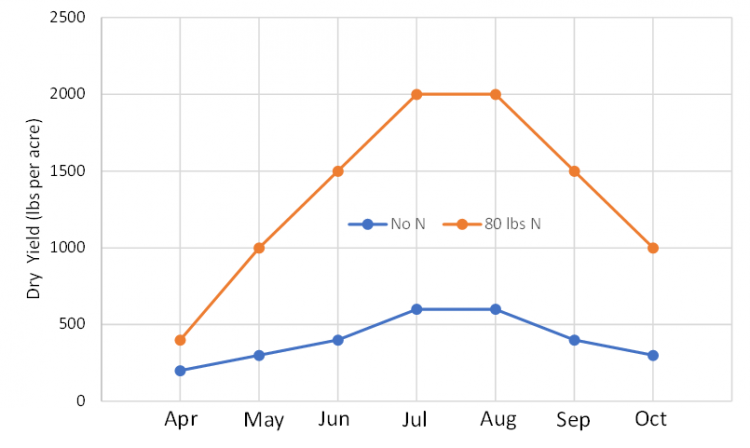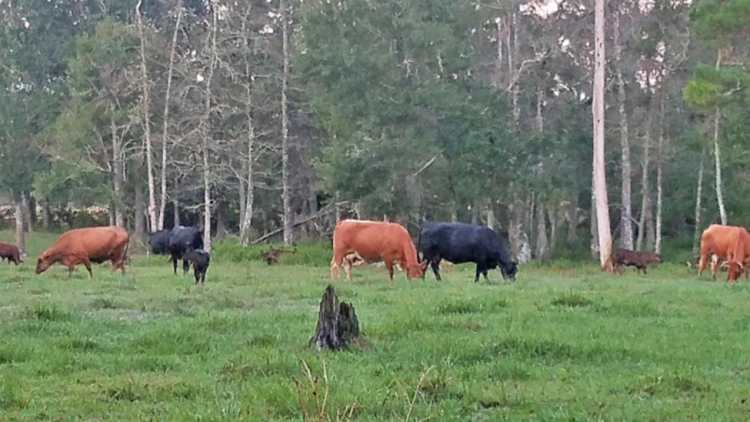Cheryl Mackowiak, UF/IFAS Soil Fertility/Water Quality Specialist
These are challenging times, and you may not currently have funds available for pasture maintenance. The good news is that you may be able to put off fertilizing your pastures for a time to save money. To determine if waiting to fertilize is a viable option for your operation, you must answer two challenging questions: 1) How much forage do you need? 2) How soon do you need it? If you need a burst of production over the next month, you probably want to fertilize (especially with nitrogen) as soon as you can. However, if your current forage production seems adequate, or only a bit low, you can probably delay fertilizing with nitrogen (N) for at least another month, or perhaps the entire season.
–
3 Major Factors Influence Forage Yield
Let us briefly review that there are three major factors driving summer forage growth: 1) daylength, 2) soil moisture, and 3) soil fertility. We have no control over daylength. Your bahiagrass production will increase with the increasing daylength and then gradually decline as the days shorten, regardless of how much nitrogen you apply (Figure 1). Since yields will increase naturally as the days lengthen over the next 8 weeks, maybe you do not need to significantly boost production with N fertilization. This evaluation needs to be made based on how pastures are currently performing and your forage needs during the next few months; perhaps you could hold off fertilizing pastures until mid-summer.
Soil moisture is typically something you cannot control, unless you have access to irrigation. The good news here is that only when soils become noticeably dry (below 10 inches depth or so) do we expect a well-managed bahiagrass pasture or hay field to lose potential yield. However, the forage can’t take in soil nutrients (including N), without soil moisture. Another issue that can occur in drought is N will accumulation in a relatively small amount of forage, resulting in high forage nitrates. This is because mineral fertilizer nutrients are taken up by roots in water-soluble forms; requiring the presence of soil water to enter plant roots. Organic N takes even longer to reach the plant, because it must first be converted (through the mineralization processes) to inorganic forms.

Figure 1. Example of bahiagrass monthly harvests if N fertilizer is withheld or reapplied at 80 lbs N/ac after each harvest. Credit: C. Mackowiak, UF/IFAS
–
Of the three factors covered here, soil fertility is one that you have control over. You can throttle summer bahiagrass production up or down by how much nitrogen is applied (within reason). Bahiagrass productivity increases with increasing N rates, up to about 300 lbs N/acre, but it is not economical at higher application rates. Excess N may also increase the risk of foliar and root diseases. Application timing needs to be considered, along with rate. For example, 50 lbs N/acre applied May 1st will not produce as much four-week forage growth as it would in the four weeks following a June 1st application. Additionally, if you continually reapply N and ignore the other nutrients contributing to soil fertility, you risk throwing your bahiagrass nutrition out of balance and eventually harming production. The best way to avoid this is get a soil fertility test conducted at a minimum of every 2 to 3 years for pastures, and annually if you are producing hay (because you export a large amount of nutrients in hay).
–
Take Home Message
To summarize, you can delay fertilizing your bahiagrass fields if, 1) your forage demand will not grow faster than the current rate of forage production, 2) you do not need a large flush of growth in May and/or you want to emphasize late summer yields. There are diminishing returns as the days shorten, consequently, do not delay your N application beyond the first week of August, if you want a later season yield boost. Finally, if you are delaying a hay cutting until later in the season and your fields are small enough, consider mowing or grazing off your weeds so they do not become too well established during your fertilization hiatus. The mowing (or well-managed grazing) will also reinvigorate your grass to put out new growth (Figure 2).

Figure 2. Well-managed cattle grazing or mowing will keep weed pressure low in pastures Credit: C. Mackowiak, UF/IFAS.
- 2024 Perennial Peanut Field Day – June 6 - April 5, 2024
- Nitrogen Fertilization of Perennial Summer Grasses - June 30, 2023
- Utilizing Winter Forage Blends for Insurance Against Climate Chaos - January 13, 2023
